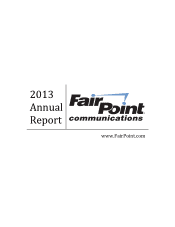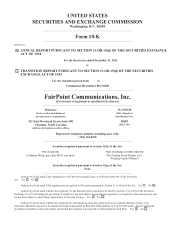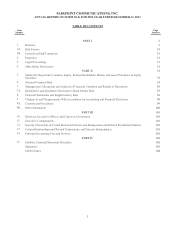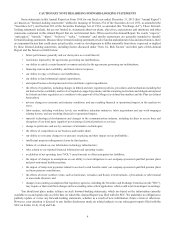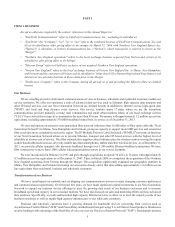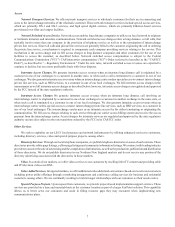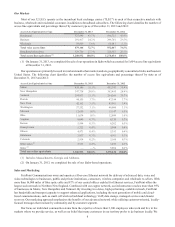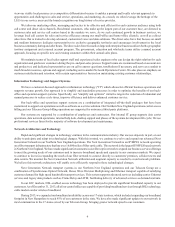FairPoint Communications 2013 Annual Report Download - page 9
Download and view the complete annual report
Please find page 9 of the 2013 FairPoint Communications annual report below. You can navigate through the pages in the report by either clicking on the pages listed below, or by using the keyword search tool below to find specific information within the annual report.7
Access
Network Transport Services. We offer network transport services to wholesale customers for their use in connecting end
users to the interexchange networks of the wholesale customer. These network transport services include special access services,
which are primarily DS-1 and DS-3 services, and high speed digital services, which are primarily Ethernet-based services
provisioned over fiber and copper facilities.
Network Switched Access Service. Network access enables long distance companies to utilize our local network to originate
or terminate intrastate and interstate communications. Network switched access charges relate to long distance, or toll calls, that
typically involve more than one company in the provision of telephone service as well as to the termination of interexchange
private line services. Since toll calls and private line services are generally billed to the customer originating the call or ordering
the private line service, a mechanism is required to compensate each company providing services relating to the service. This
mechanism is the access charge and we bill access charges to long distance companies and other customers for the use of our
facilities to access the customer, as described below. Network switched access compensation is subject to the Federal
Communications Commission ("FCC") CAF/intercarrier compensation ("ICC") Order (referred to hereafter as the "CAF/ICC
Order"), as described in "—Regulatory Environment." Under the new rules, network switched access revenues are expected to
continue to decline, but on a more predictable basis with fewer disputes.
Interstate Access Charges. We generate interstate access revenue when an interstate long distance call is originated by a
customer in one of our exchanges to a customer in another state, or when such a call is terminated to a customer in one of our
exchanges. We also generate interstate access revenue when an interexchange carrier orders special access to connect interexchange
private line services, such as HSD services, to a customer in one of our local exchanges. We bill interstate access charges in the
same manner as we bill intrastate access charges as described below; however, interstate access charges are regulated and approved
by the FCC instead of the state regulatory authority.
Intrastate Access Charges. We generate intrastate access revenue when an intrastate long distance call involving an
interexchange carrier is originated by a customer in one of our exchanges to a customer in another exchange in the same state, or
when such a call is terminated to a customer in one of our local exchanges. We also generate intrastate access revenue when an
interexchange carrier orders special access to connect interexchange private line services, such as HSD services, to a customer in
one of our local exchanges. The interexchange carrier pays us an intrastate access fee for either terminating or originating the
communication. We bill access charges relating to such service through our carrier access billing system and receive the access
payment from the interexchange carrier. Access charges for intrastate services are regulated and approved by the state regulatory
authority and are also subject to the rate transitions ordered by the FCC in its CAF/ICC order.
Other Services
We seek to capitalize on our LECs' local presence and network infrastructure by offering enhanced services to customers,
including directory services, video and special purpose projects, among others.
Directory Services. Through our local telephone companies, we publish telephone directories in some of our locations. These
directories provide white page listings, yellow page listings and community information listings. We contract with leading industry
providers to assist in the sale of advertising and the compilation of information, as well as the production, publication and distribution
of these directories. We do not publish directories in our Northern New England markets and do not receive any portion of the
directory advertising associated with the directories in those markets.
Video. In certain of our markets, we offer video services to our customers by reselling DirecTV content and providing cable
and IP television video-over-DSL.
Value Added Services. In targeted markets, we offer additional value added and convenience-based services for our customers
including power utility offerings through a marketing arrangement and conference calling services for business and residential
customers, among others. We are continually working to build stronger relationships with our customers as their needs evolve.
Special Purpose Projects. Upon request from customers, we provide project-based implementation support services. These
services are provided on a time and materials basis at the customer location as part of a larger FairPoint solution. This capability
allows us to better serve our customers and assist in filling resource gaps they may encounter when implementing new
communications plans.

